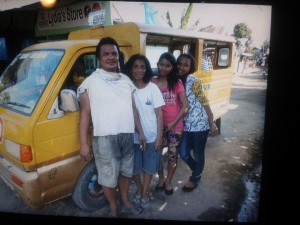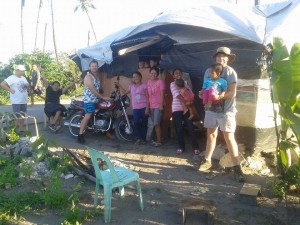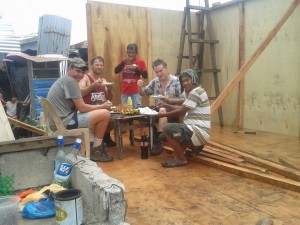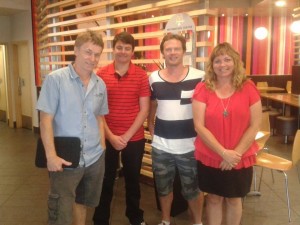As a small group of New Plymouth volunteers touched down back home in New Plymouth Steve Bowkett was already planning a third trip back to Tacloban.
“Right up to the last day we were still meeting people that we would of liked to help. I would like to go back in September.”
“I’ve told my church that I will go back. It does tug on the heart strings. You see the need and how badly off they are. You just give a hand. I enjoy it and it’s fun.
“We don’t give out any cash. They might ask but we just build them a house, give them a sack of rice, school supplies or something like that.”
A furniture builder by trade and owner of Artesano in Fitzroy, New Plymouth, he enjoys travelling to disaster areas around the world helping others by offering whatever skills he can.
“Last year we started in Barangay 79 after Typhoon Yolanda ravaged the Phillipines. A local, Emma, gave us a list of people around her neighbourhood that really needed help. I still hear from a few of them on facebook.
This trip Steve was joined by Justin Butler, Zavia Smith and Lynette Betteridge.
“It took quite awhile to get a team but I got the right people at the right time. We worked well together.”
 “We started work at 8 and if it was a clear sunny day it was too hot and we were worn out by about 11. We would push on until about 12 or 1 and then you would need a break. So we would actually go back to our room as you felt like washing and changing your clothes. We would just be dripping with sweat.
“We started work at 8 and if it was a clear sunny day it was too hot and we were worn out by about 11. We would push on until about 12 or 1 and then you would need a break. So we would actually go back to our room as you felt like washing and changing your clothes. We would just be dripping with sweat.
“The locals pace themselves. They thought I was a crazy white man up there swinging on a hammer. Mad dogs and Englishmen stay out in the midday sun was an Indian saying right? He says bursting into laughter.
“We had a job to do and just got on with it.”
Steve’s group spent two weeks working hard with the locals and for the locals attempting to put some sort of normality back in their lives.
“I had these contacts of people to meet. Last year we started in Barangay 79 and Emma gave us a list of people around her neighbourhood that really needed help.
 “I was fulfilling a promise going back for Emma’s sister Gemma who was still living in a tent in the tent city by the sea. Last year Alex and I took her sack of rice. I said to myself that I was going to go back and build her a house. She was still living in a kind of tent shelter. She had added bits of tarpaulin, bits of iron, bits of everything to make a house.”
“I was fulfilling a promise going back for Emma’s sister Gemma who was still living in a tent in the tent city by the sea. Last year Alex and I took her sack of rice. I said to myself that I was going to go back and build her a house. She was still living in a kind of tent shelter. She had added bits of tarpaulin, bits of iron, bits of everything to make a house.”
Other aid agencies have been doing their bit in the area too as Steve’s group discovered.
“So just up the road a bit we added to an Oxham house that was just half made. They had a certificate on it how much they had spent. It was 20,000 pesos. I knew that that wouldn’t finish a house but basically they had framed it up.
“It was only one or two walls done with some plywood half finished. I think they provide the money to a reputable person of the family to get it done and then they check to make sure it is. But there was such a need there.
“I know that you need about 40,000 pesos to complete a home. The coconut wood is cheaper than the plywood so they framed up with coconut wood. Where we were using more plywood but it was quicker so we built three homes like that then we reclad a home of a single mother. We were also supplying neighbours with whatever they required like plywood, iron or wood to finish their homes throughout the three weeks.”
Steve has spent considerable time researching and experimenting with quicker and more efficient ways of building as many houses as they can in the shortest time.
“We put the floor down and then stood up the walls that we had made separately. It was all lining up which made it a lot quicker. We are basically making a kit and then putting them up.
“We bought local plywood. We used the local materials from the hardware shop that was owned by a Chinese bloke who is now the third generation. They got flooded out and all their nails were brown.
 “We bought a lot of plywood and iron nails off them. We used coconut wood from further down the road. We would buy materials every morning. We hired a bus driver to drive it. He was good and very helpful. He was a really friendly guy.
“We bought a lot of plywood and iron nails off them. We used coconut wood from further down the road. We would buy materials every morning. We hired a bus driver to drive it. He was good and very helpful. He was a really friendly guy.
The group got told about a new suburb on the edge of town which got hit hard by the typhoon as it was more exposed.
“Sixty percent of the Phillipine population is actually squatting. They didn’t buy their land. They have no title, but no one will kick them off it. It is handed down to their children. Imagine though the families that have three or four siblings they have to move somewhere else.
“We went to this new suburb of concrete houses that had just got smacked by the typhoon. I could see it was kind of more exposed. There were green fields and it was elevated a bit above the city. The typhoon had gone straight through there.
“Some of the buildings were abandoned. The roof structure was made of steel and it was all ripped and torn and lots torn off completely. It had cracked the concrete as it went. These houses were wrecked.
“I can see these people worse off than the poorest. They have put their life savings into this house and I don’t think they have insurance for typhoons. It would cost 50,000 pesos for those homes, they are really dinky. It’s probably like to us $100,000. So they have lost everything and are probably living somewhere else with relatives or in a shanty town.”
“The poorest people just go and gather up scraps of iron and plywood. They cook on the ground on a little concrete stove like structure. They haven’t lost their life savings doing it they just put up the scraps and have a home again. It is pretty rough as it is hard for families.
Strangely one thing that did seem to survive from the houses was the concrete or tiled room that people used as their bathroom.
“That was where they would splash water on themselves and there was a toilet in there as well. You know Asian style washing with a bucket. We built a house alongside that and then built a lean to over the top to the toilet and a concrete kitchen bench.
“We then built a tiny house for a couple that had children. There was still an old toilet outside. We made a house which was only one bedroom and one little living area. So they cooked on the ground and then there was the toilet. It was just to put a roof over their heads.
It always takes Steve time to readjust to the different living conditions on his return to his home base in Fitzroy New Plymouth. The local
“Well my biggest impression was the second or third day I was back in NZ I was asked to go and measure up a job at a house. It was down this beautiful drive of trees.
“That was quite a shocker from the slums and then to visit this beautiful home. That hit me hard, our affluence here compared to the slums there. In a way they don’t care about the little tiny details. They just want a roof.
“As we were near the end of our stay this trip a local, Thenaj, asked me to help her with a house. I said I can’t as we are on our last days and the money has gone. I said I will probably be back. I have to go back to keep my word.”
He is now planning a return visit in September and is looking for volunteers to join him.
If you are interested you can contact Steve Bowkett at Artesano, 43 Beach St, New Plymouth or call him on 027 755 1395

